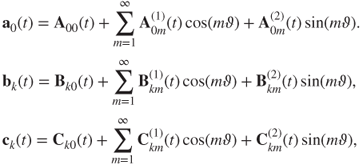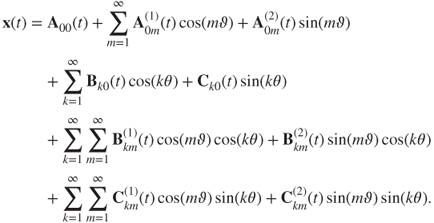Chapter 3
An Analytical Method for Periodic Flows
In this chapter, from Luo (2012a), the analytical dynamics of periodic flows and chaos in nonlinear dynamical systems will be presented. The analytical solutions of periodic flows and chaos in autonomous systems will be discussed first, and the analytical dynamics of non-autonomous nonlinear dynamical systems will be presented. The analytical solutions of periodic motions in free and periodically excited vibration systems will be presented. In a similar fashion, the analytical solutions of periodic flows for time-delayed nonlinear systems will be presented with/without periodic excitations, and time-delayed nonlinear vibration systems will also be discussed for engineering applications. The analytical solutions of periodic flows and chaos are independent of the small parameters, which are different from the traditional perturbation methods. The methodology presented herein will end the history of chaos being numerically simulated only.
3.1 Nonlinear Dynamical Systems
In this section, analytical periodic flows in autonomous and periodically forced, nonlinear dynamical systems will be discussed. A generalized harmonic balance method with the Fourier series expressions will be presented for such analytical, periodic flows, and chaos in nonlinear dynamical systems. The local stability and bifurcation theory of equilibriums in nonlinear autonomous systems of coefficients in the Fourier series solutions will be employed to classify analytical solutions of periodic flows and chaos in nonlinear dynamical systems.
3.1.1 Autonomous Nonlinear Systems
Periodic flows in autonomous dynamical systems will be presented herein. If an autonomous nonlinear system has a periodic flow with period ![]() , then such a periodic flow can be expressed by a generalized coordinate transformation based on the Fourier series. The method is stated through the following theorem.
, then such a periodic flow can be expressed by a generalized coordinate transformation based on the Fourier series. The method is stated through the following theorem.
If the Hopf bifurcation of equilibriums of Equation (3.6) occurs, there is a periodic solution of generalized coordinates in Equation (3.5) with a frequency ![]() . Thus, the periodic solution of the generalized coordinates can be expressed as a new generalized coordinate transformation with
. Thus, the periodic solution of the generalized coordinates can be expressed as a new generalized coordinate transformation with ![]()
Substitution of Equation (3.14) into Equation (3.5) yields
If the new solution is still periodic with excitation period ![]() , then for specific
, then for specific ![]() , we have
, we have
For this case, ![]() should be inserted because
should be inserted because ![]() terms are already included in the Fourier series expression. Thus,
terms are already included in the Fourier series expression. Thus,
For ![]() , the period-1 flow is obtained, and Equation (3.15) will become Equation (3.5). For the period-m flow, we have a new generalized coordinate transformation as
, the period-1 flow is obtained, and Equation (3.15) will become Equation (3.5). For the period-m flow, we have a new generalized coordinate transformation as
If ![]() with a prescribed small
with a prescribed small ![]() , the solution of period-m flow in Equation (3.18) can be approximated by a finite term transformation as
, the solution of period-m flow in Equation (3.18) can be approximated by a finite term transformation as
If ![]() for any
for any ![]() and
and ![]() , the solution will be quasi-periodic or chaotic instead of periodic. Herein, this case will not be discussed. If period-1 motion possesses at least
, the solution will be quasi-periodic or chaotic instead of periodic. Herein, this case will not be discussed. If period-1 motion possesses at least ![]() harmonic vector terms, then the total harmonic vector terms for period-m flow should be
harmonic vector terms, then the total harmonic vector terms for period-m flow should be ![]() . Similarly, the period-m flows in nonlinear dynamical systems can be discussed.
. Similarly, the period-m flows in nonlinear dynamical systems can be discussed.
If ![]() , Equation (3.20) will give the analytical expression of chaos in dynamical systems in Equation (3.1), which can be approximated by Equation (3.23) under the condition of
, Equation (3.20) will give the analytical expression of chaos in dynamical systems in Equation (3.1), which can be approximated by Equation (3.23) under the condition of ![]() . The route from the periodic flow to chaos is through the Hopf bifurcation.
. The route from the periodic flow to chaos is through the Hopf bifurcation.
3.1.2 Non-Autonomous Nonlinear Systems
Periodic flows in periodically excited nonlinear dynamical systems will be presented herein. If a periodically excited nonlinear system with an external period ![]() has a periodic flow, then such a periodic flow can be expressed by a Fourier series. The methodology is presented through the following theorems.
has a periodic flow, then such a periodic flow can be expressed by a Fourier series. The methodology is presented through the following theorems.
Because they are similar to the autonomous nonlinear system, period-m flows in the periodically excited, nonlinear dynamical system in Equation (3.32) can be discussed.
If ![]() , Equation (3.45) will give the analytical expression of chaos in periodically excited, nonlinear dynamical systems in Equation (3.32), which can be approximated by Equation (3.48) under the condition of
, Equation (3.45) will give the analytical expression of chaos in periodically excited, nonlinear dynamical systems in Equation (3.32), which can be approximated by Equation (3.48) under the condition of ![]() as
as ![]() .
.
3.2 Nonlinear Vibration Systems
In this section, the analytical solutions of periodic motions for nonlinear vibration systems are presented owing to extensive application, and the local stability and bifurcation theory will be applied to determine the stability and bifurcation of approximate solutions of periodic motions in nonlinear vibration systems.
3.2.1 Free Vibration Systems
Periodic motions in nonlinear vibration systems will be presented herein. If such a vibration system has periodic motions with period ![]() , then such periodic motions can be expressed by the Fourier series.
, then such periodic motions can be expressed by the Fourier series.
If the Hopf bifurcation of equilibriums of Equation (3.67) occurs, there is a periodic solution of coefficients in Equation (3.62) with a frequency ![]() . As discussed from Equation (3.14) to Equation (3.19), there is a period-m motion as in Equation (3.18). If
. As discussed from Equation (3.14) to Equation (3.19), there is a period-m motion as in Equation (3.18). If ![]() for any
for any ![]() and
and ![]() , the solution will be quasi-periodic or chaotic instead of periodic. Herein, the period-m motions in vibration systems will be discussed only.
, the solution will be quasi-periodic or chaotic instead of periodic. Herein, the period-m motions in vibration systems will be discussed only.



